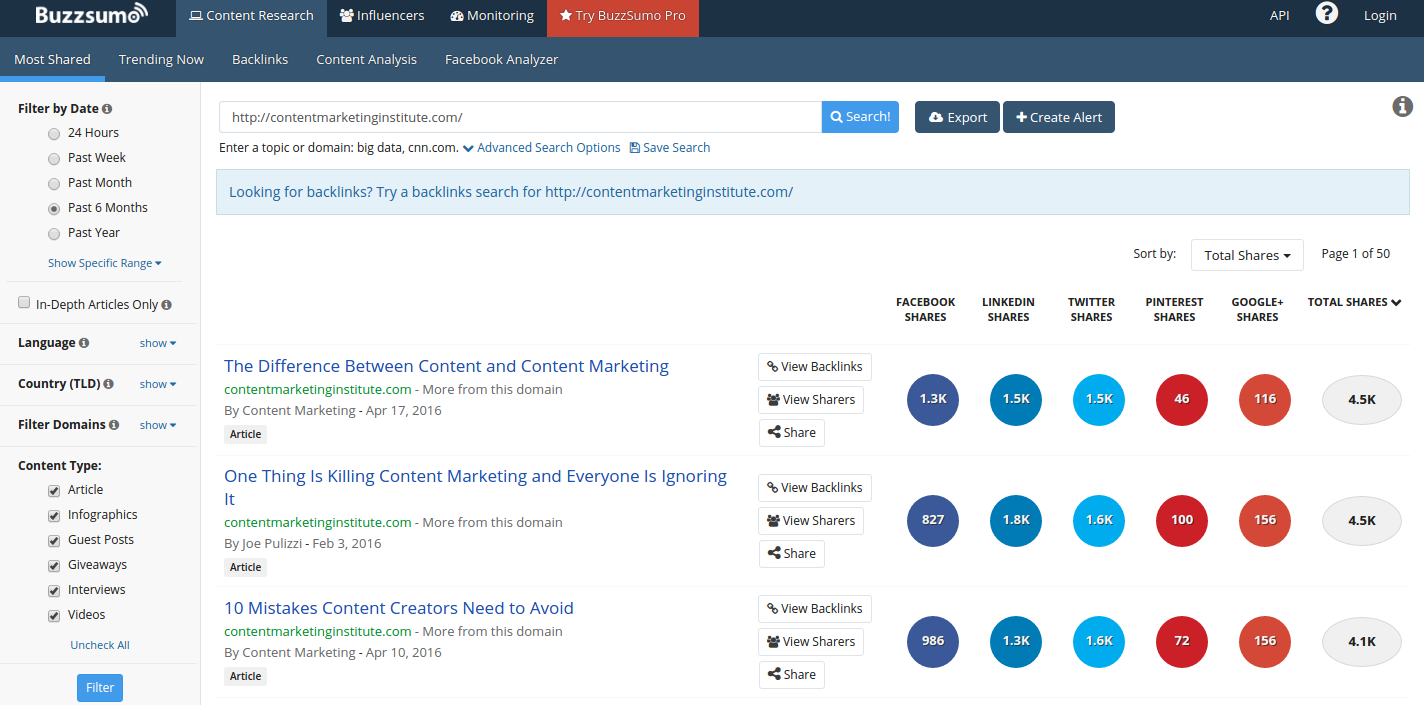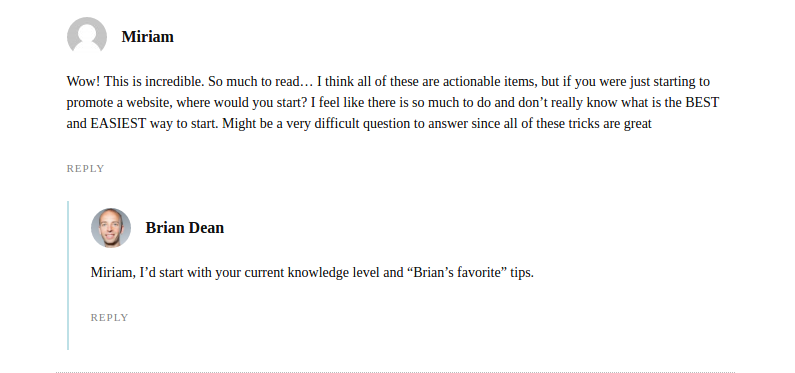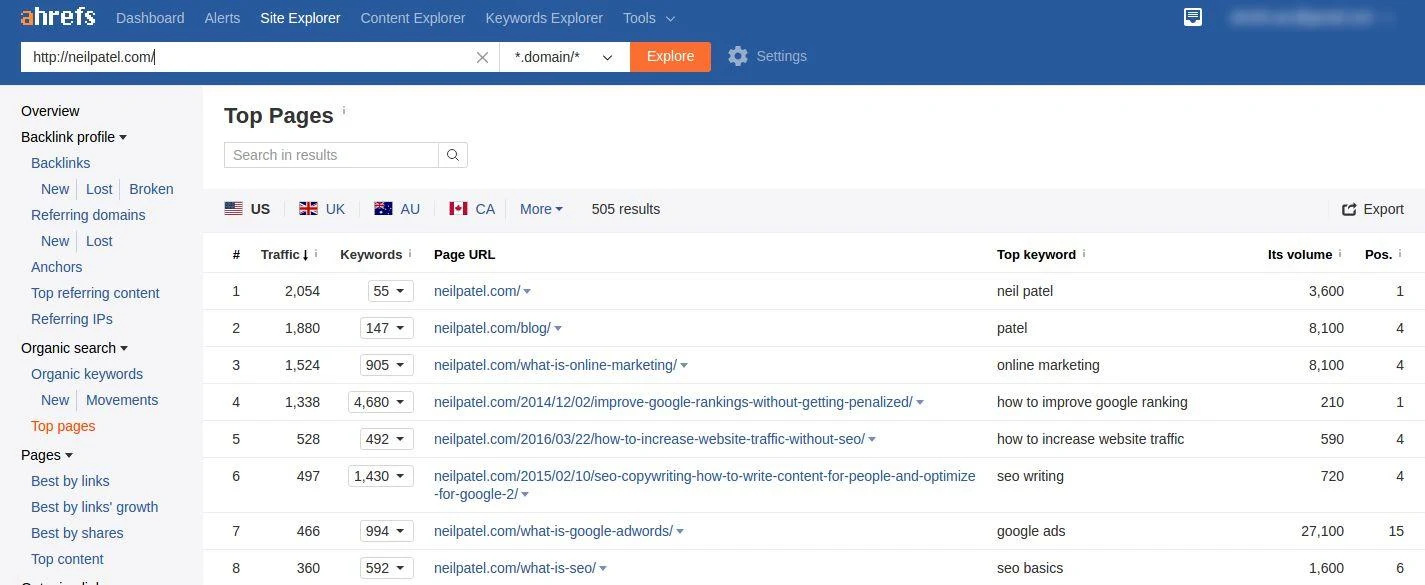You’ve been working on an awesome piece of content for a week already and it couldn’t have been better - you’ve done a very deep research, processed tons of data, put together a gorgeous-looking infographic, and sprinkled your post with juicy language.
“It’s going to generate so much buzz that Google will rank my article in top 10 within a few hours”, - you thought.
You hit “Publish” and Bam!
Just 25 minutes later you get 7 fresh comments!
You can’t hold your excitement anymore as you start reading the comments just to find out that they were placed by someone called “essay” and contain some generic compliment about how great and useful your article was.
But zero comments from real people, though.
Does it sound familiar?
Probably, yes.
How could it happen if you put so much time and effort into this incredible piece of content?
Probably, because you wrote on the topic interesting to YOU and not to your audience.
Let’s take a second and think why visitors come to your site after all.
Are they in love with you as a writer? Could be, but more often than not, they probably don’t even care how great your writing skills are.
William Raltson, senior marketing specialist at Chicago SEO Services, says that “People come to your site because they are looking for answers and guidance for THEIR problems, THEIR projects to get the stuff THEY want”.
How to identify the needs of your audience? Read on to find out!
Time for Some Self Analysis
1. Evaluate Posts On Your Site.
Take a look at your posts which generated the highest engagement and social media shares. Put the titles in a spreadsheet. Do you see any patterns? You’ll be able to identify popular topics which interest your audience immediately. Do some more research into the topics and create even better content around them.
One of the easiest ways to measure the popularity of your posts on social media is to use Buzzsumo. You just need to put in a URL and specify a date range and... voila! You now see your most popular content which performed best on Facebook, LinkedIn, Google+, Pinterest and even Twitter. By the way, Buzzsumo is the only tool which measures number of Twitter shares after Twitter removed the data in 2015.
Let’s take a look at the content that has been doing best on Content Marketing Institute over the past 6 months.

Awesome, ha?
Psst, you can also use this tool to spy on your competitors. But don’t tell anyone!
One of the easiest ways to measure the popularity of your posts on social media is to use Buzzsumo. You just need to put in a URL and specify a date range and... voila! You now see your most popular content which performed best on Facebook, LinkedIn, Google+, Pinterest and even Twitter. By the way, Buzzsumo is the only tool which measures number of Twitter shares after Twitter removed the data in 2015.
Let’s take a look at the content that has been doing best on Content Marketing Institute over the past 6 months.
Awesome, ha?
Psst, you can also use this tool to spy on your competitors. But don’t tell anyone!
2. Peruse your comments.
That’s a no-brainer. Just sit down and read what your readers are actually talking about. That’s a great source of insight which will give you a better understanding of who your followers are and what gets them excited. Their reactions and questions can give you lots of ideas of what to write next about.
Let’s take a look at SEO guru Brian Dean’s most recent post “SEO Tips: The Complete List (201 Actionable Techniques)” which has generated more than 300 comments.

Miriam wants to know how to start promoting a website which can be an excellent idea for a new blog post.
Let’s take a look at SEO guru Brian Dean’s most recent post “SEO Tips: The Complete List (201 Actionable Techniques)” which has generated more than 300 comments.
Miriam wants to know how to start promoting a website which can be an excellent idea for a new blog post.
3. Ask your audience.
If you want to hit the bull’s eye, just reach out to your readers with a quick survey. You’ll be surprised about how much feedback and new information you’ll receive in no time!
Linda Formicelli of The Renegade Writer shares her first experience of surveying her readers in this epic post on Smart Blogger:
Linda Formicelli of The Renegade Writer shares her first experience of surveying her readers in this epic post on Smart Blogger:
“I posted the survey to Twitter and Facebook and sent it to my email subscribers, offering a suite of my e-books to one random respondent as an incentive to fill out the form.
Within a few days I had 380 responses and was shocked to discover that many of my readers wanted scripts, templates, and workbooks – products I had never even considered creating”.
Rediscover Your Niche
Knowing what is going on in the outside world is extremely important to keep up with the trends and create content which addresses current problems your target audience might be experiencing.4) Identify Hot Topics.
How do you know what’s trending these days? The easiest way is to go through a couple of top sites in your niche and see what they are writing about. Personally I like to organize niche sites in Feedly which gives me a quick overview of what the world is talking about.

Another road to travel is to use our good old friend BuzzSumo again which also shows the most shareable content in your desired niche. Equip yourself with a couple of meaningful keywords and there you have it - a list of most awesome content which your target audience loved.

Another road to travel is to use our good old friend BuzzSumo again which also shows the most shareable content in your desired niche. Equip yourself with a couple of meaningful keywords and there you have it - a list of most awesome content which your target audience loved.
5) Steal a peek at your competitors.
You should always know what your competitors are doing in order to stay on top of your game. Ahrefs is an incredibly useful tool in terms of competitor analysis. It gives a huge load of different data such as keywords your competitors are targeting, their traffic, authority, backlinks and much much more.
For our purposes, especially useful would be the “Top pages” report which shows the pages which generate highest traffic, keywords they are ranking for and their positions in the search engines.
Let’s take a look at the almighty Neil Patel’s website.

As you can see, Neil’s most popular posts usually come in a how-to form explaining ways to achieve certain goals such as search rankings improval or how to excel in copy-writing.
Start monitoring your competitors in order to build your own strategy on how to conquer the world!
For our purposes, especially useful would be the “Top pages” report which shows the pages which generate highest traffic, keywords they are ranking for and their positions in the search engines.
Let’s take a look at the almighty Neil Patel’s website.
As you can see, Neil’s most popular posts usually come in a how-to form explaining ways to achieve certain goals such as search rankings improval or how to excel in copy-writing.
Start monitoring your competitors in order to build your own strategy on how to conquer the world!
6) Listen to a beautiful melody of the Tweet.
Twitter can be a powerful indicator of the most trending topics out there. Fill in the search box with your target keyword and just like that you can see the most popular content in your niche along with the multiple discussions which are so valuable.

Ability to listen and observe is what helps us all to see new opportunities and convert them into tremendous results. We hope that this article will help you to look at the digital world with new eyes and will serve as a start of an exciting journey to more engaging and meaningful content as well as qualitatively new and stronger relationships with your audience.
Author Bio
Ability to listen and observe is what helps us all to see new opportunities and convert them into tremendous results. We hope that this article will help you to look at the digital world with new eyes and will serve as a start of an exciting journey to more engaging and meaningful content as well as qualitatively new and stronger relationships with your audience.
Author Bio
Chris is a marketing specialist and a blogger from California. When not eating hot dogs and rooting for Lakers, he loves exploring the Digital World and helping others to embark on their own digital adventures. Follow him on Facebook and Twitter.
Top image credit: bigstock

